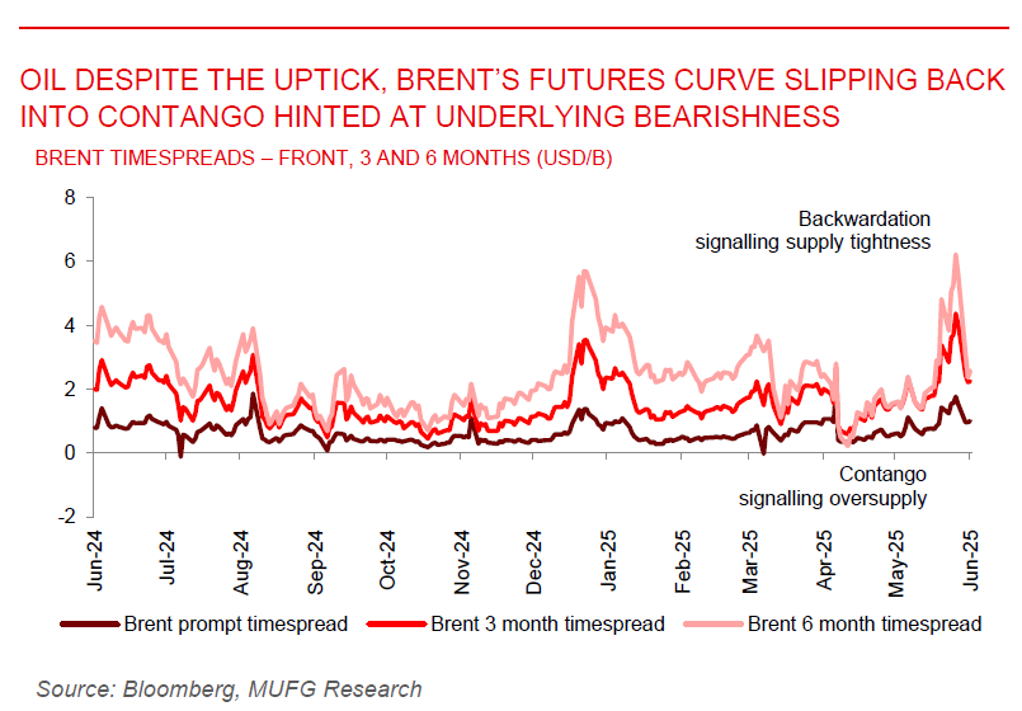To read the full report, please download the PDF above.
Middle East Daily
SOOJIN KIM
Research Analyst
DIFC Branch – Dubai
T: +44(4)387 5031
E: soojin.kim@ae.mufg.jp
MUFG Bank, Ltd. and MUFG Securities plc
A member of MUFG, a global financial group
Middle East Daily
COMMODITIES / ENERGY
Oil rebounded slightly after sharp selloff, but market remains cautious. Oil prices edged higher about 1% to nearly USD68/b, recovering modestly after a steep 13% two-day drop, the worst since 2022. The bounce came as traders reassessed the Iran-Israel ceasefire and digested reports of a 4.3 million barrel decline in US crude stockpiles. Still, sentiment remained fragile. Earlier optimism around the truce was complicated by President Trump’s mixed signals, allowing China to resume Iranian oil imports while insisting sanctions remain. The slight rebound was seen as a technical correction rather than a shift in trend, with focus now turning to broader economic signals, upcoming US tariff deadlines, and the next OPEC+ meeting on 6 July. Despite the uptick, Brent’s futures curve slipping back into contango hinted at underlying bearishness.
Gold steadied near USD3,300/oz as ceasefire eases haven demand. Gold hovered near USD3,300/oz after 1.3% drop, as easing geopolitical tensions between Iran and Israel reduced demand for safe-haven assets. While gold has gained 27% this year, boosted by central bank buying and trade uncertainty, the rally has stalled in recent months, with prices largely rangebound between USD3,300/oz and USD3,400/oz. weak US consumer confidence in June added to economic concerns, potentially paving the way for Fed rate cuts, though Chair Powell remains cautious. Lower rates typically support gold, but gold is treading water as markets weigh global risks and monetary policy signals.
MIDDLE EAST - CREDIT TRADING
End of day comment – 24 June 2025. London closed yesterday with Iran starting to attack the US base in Qatar and London walked in this morning with a ceasefire between Israel and Iran. That immediately led to a repricing of 5bp tighter across credits/ curves. With some inflows and short covering the market was on average 10bp tighter at some stage before we saw some sellers stepping in. The afternoon saw UST rally which brought some buyers out into the close mainly from ETF side but also kept the spread tightening in IG credit a bit at bay. IG sovereign are closing -5bp, again ADGB is better bid than QATAR where the market still feels long. The bid in ADGB was led by long end bonds 49s closing +0.75pt/-6bp. In higher beta credits MOROC outperformed today, not seen much selling even at 10bp tighter spreads, 33s outperformed closing +0.75pt/-10bp. Away from sovereign DPWDU outperformed in the corps space unwinding the widening on the back of trade disruption fears in one trading day. Seen buyers across the curve 28s, 29s and 33s mainly. 33s closing +0.75pt/-10bp. Macro and GCC markets reacted strongly to the ceasefire news, especially since it seems to be holding. The primary market saw more EM issuers announcing deals and issuers should have a good window here to get issuance done before the summer holiday period.
MIDDLE EAST - MACRO / MARKETS
Fitch affirmed UAE’s `AA-` rating with stable outlook. Fitch rating has reaffirmed the UAE’s rating at `AA-` with a stable outlook, supported by its low consolidated government debt, large net external assets, and high GDP per capital, largely underpinned by Abu Dhabi’s sovereign wealth. The agency highlighted the UAE’s continued budget surplus, low fiscal breakeven oil price (USD45-50/b), and projected GDP growth of 5.2% in 2025, fuelled by rising oil output and robust non-oil sector expansion. However, Fitch notes vulnerabilities including high economy-wide leverage from government-related entities (GREs), limited fiscal flexibility at the federal level, and elevated geopolitical risks.
Saudi Arabia raised USD628 million in June Sukuk. Saudi Arabia’s National Debt Management Center completed its June domestic sukuk issuance, raising SAR2,355bn (USD628 million), a 42% drop from May’s record issuance, reflecting normal monthly variation. The offering was split across five tranches maturing between 2027 and 2039, as the Kingdom continues to deepen its local debt market with Shariah-compliant instruments. Despite the decline, Saudi Arabia remains the GCC’s top debt issuer, accounting for over 60% of regional primary debt in Q1 2025, with USD31bn raised across 41 deals, with USD168bn in bonds maturing through 2029 and strong momentum in both local and foreign currency sukuk issuance.

